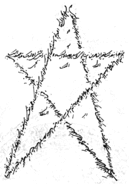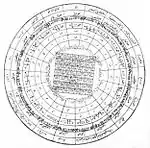Talismans in the Bábí and Baháʼí Faiths
Talismans are referred to in several of the writings of the Báb, founder of the Bábí Faith,[1] and to a lesser extent in the writings of Baháʼu'lláh, founder of the Baháʼí Faith.[2]
| Part of a series on |
| Bábism |
|---|
 |
| Founder |
| Prominent people |
| Key scripture |
| History |
| Divisions |
| Other topics |
|
In Bábism
A Da'ira (دائرة circle) is a symbolic circular talisman for women described by the Báb. For men he instructed the use of a Haykal (temple), a five-pointed star.[3] The Báb stated that these terms should not be interpreted too literally, and that one should focus on their spiritual meaning.[4] The purpose was that the texts on the paper should appear in the heart of the person carrying it.[5] The Haykal is a symbol for the Manifestation of God, while the circle refers to the "Sun of Truth," another term for the Manifestation of God. Their purpose was constant awareness of the symbolic meanings, and to help the Bábís to recognize "He whom God shall make manifest" when he would appear.[4]
In the Baháʼí Faith
Baháʼu'lláh, who claimed to be the one promised by the Báb, de-emphasized the esoteric elements of Bábism (including alchemy [6][7]) and stressed rationality. He stated for example "Man is the supreme Talisman. Lack of a proper education hath, however, deprived him of that which he doth inherently possess."[8][9] Baháʼí scholar Udo Schaefer writes that Baháʼu'lláh uses the talisman as a metaphor, and that humans possess two properties of a talisman when they try "to follow their true spiritual vocation". They have the capacity to do good deeds and attract blessings, and are able to ward off evil from themselves or others.[8]
The Súriy-i-Haykal (Tablet of the Temple) of Baháʼu'lláh, which includes his messages addressed to Pope Pius IX, Napoleon III, Tsar Alexander II of Russia, Queen Victoria, and Naser al-Din Shah Qajar, was written in the form of a Haykal.[10]
Additionally, there are some prayers that offer talismanic protection, for example, the Long Healing Prayer and some prayers for protection.[11]
Gallery
 Haykal by the Báb written in his own hand.
Haykal by the Báb written in his own hand. An unidentified tablet in the form of a Haykal, in the Báb's handwriting.
An unidentified tablet in the form of a Haykal, in the Báb's handwriting. A Bábí Da'ira, printed in gold and incorporating script in the Báb's own hand.
A Bábí Da'ira, printed in gold and incorporating script in the Báb's own hand.
See also
References
- Lambden, Stephen. Haykal and Dhar'ia: Talismanic Temples and Circles and other esoteric writings of the Bāb.
- Smith, Peter (2000). "talismans". A concise encyclopedia of the Baháʼí Faith. Oxford: Oneworld Publications. pp. 333–334. ISBN 1-85168-184-1.
- Denis MacEoin (1994). Rituals in Babism and Baha'ism. UK: British Academic Press and Centre of Middle Eastern Studies, University of Cambridge. pp. 14–21. ISBN 1-85043-654-1.
- Saiedi, Nader (2008). Gate of the Heart. Waterloo, ON: Wilfrid Laurier University Press. pp. 330–331. ISBN 978-1-55458-035-4.
- Moojan Momen (2019). The Star Tablet of the Bab. British Library Blog.
- Brown, Keven (2002/2012). A Reflection on the Theory of Alchemy as Explained in the Baháʼí Writings.
- Brown, Keven (1997). Hermes Trismegistus and Apollonius of Tyana in the Writings of Baháʼu'lláh in Revisioning the Sacred: New Perspectives on a Baháʼí Theology, Studies in the Babi and Baháʼí Religions, vol. 8, pp. 153-187. Kalimat Press, Los Angeles.
- Schaefer, Udo (2007). Baháʼí Ethics in Light of Scripture, Volume 1 - Doctrinal Fundamentals. Oxford, UK: George Ronald. p. 52. ISBN 0-85398-505-7.
- Shahvar, Soli (2009). The Forgotten Schools: The Baháʼís and Modern Education in Iran 1899-1934. International library of Iranian studies. 11 (illustrated ed.). I. B. Tauris. ISBN 1845116836.
- Bayat, Mohamad Ghasem (2001). An Introduction to the Súratu'l-Haykal (Discourse of The Temple) in Lights of Irfan, Book 2.
- Including a prayer of the Báb, the original of which was written in the Báb's own hand, in the form of a pentacle, and a prayer of Baháʼu'lláh.
